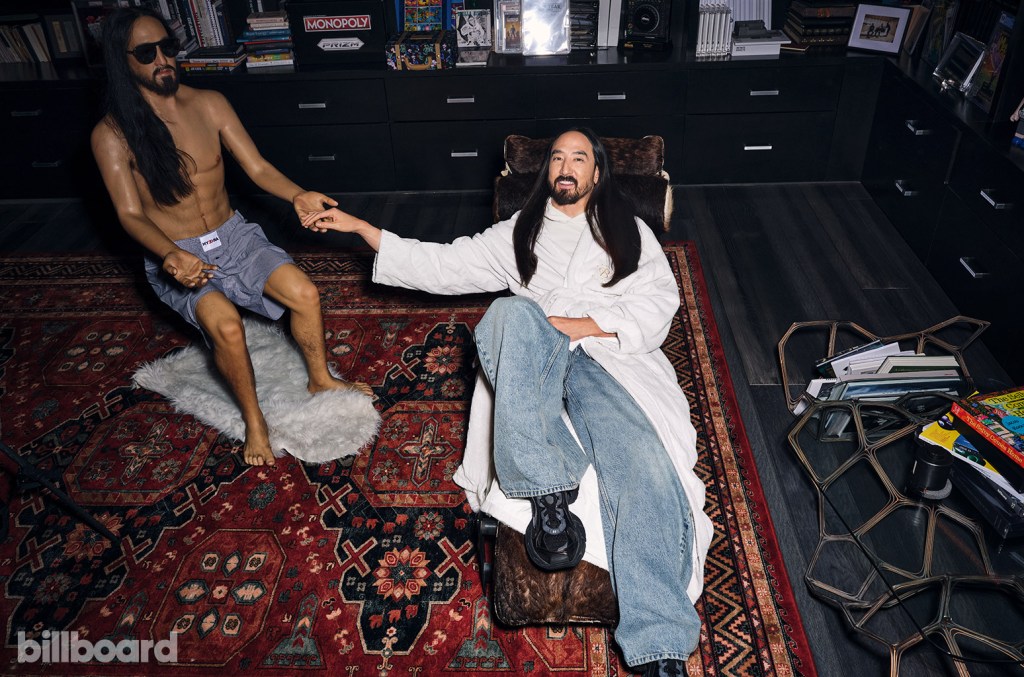In addition to our Steve Aoki cover story, check out this Q&A with Jessica Chou, who photographed Aoki for Billboard‘s AAPI issue.
Tell us a little about your own background.
I’m from the San Gabriel Valley – a suburb in Los Angeles. Interesting fact: the city I grew up in was the first city in the U.S. to reach a majority-Asian population according to the 1990 U.S. Census. I feel like growing up in a suburb with a majority-minority population has informed my views and experience on American life.
I’ve been working as a freelance photographer for 13 years, focusing on portraiture, photographing everyday people and high-profile public figures alike. I come from a photojournalism/documentary background and I think those observational qualities of storytelling have definitely informed how I approach my portraiture.
You’ve worked with Billboard for a long time – you shot Steve for us 10 years ago, spending 36 hours with him, playing on your background in reportage. What are your standout memories from that shoot?
Gosh, 10 years. Yikes! It was such a whirlwind experience. I remember flying into Vegas and from the second I got to Steve, it was non-stop action for the next 36 hours, going from his residency in Vegas to his headlining performance at Tomorrowland in Bethel Woods, New York. I don’t think I had ever seen this kind of mix of business and play on such a high level at that point. There was such a huge intensity/euphoria that came from his fans both in Vegas and at Tomorrowland – I mean, people were begging to get caked in the face – and then there was the other side of being an artist with producing music and creating business collaborations. And Steve seemed to have this limitless amount of energy – I remember at some point thinking, “Omigosh, can we just like not do something for just a little bit? I can’t keep up.” [Laughs] But it was exhilarating. It’s still an experience I carry with me as a photographer.
What was your impression of Steve before the shoot? And what stood out to you most about him once you met?
I had some impressions of Steve before the shoot, mostly from the Cobrasnake era of the early 2000s, and him being a staple of the parties of those days. When I photographed Steve in 2014, it was at the height of EDM music in the U.S. and his show antics were such a part of that time. I just remember Steve being a very high-sensation seeker and he had a way of provoking and creating that experience. I think it’s what sets him apart as an artist and an individual. And so much of house and techno music is about freeing your mind for new experiences, but there are only so many personalities that can follow through on that mantra while still being put together.
How did that experience influence how you came up with the creative for this new cover and feature with Steve? Can you talk a little about that concept?
I think Steve’s level of energy with this laid-back attitude has always been an interesting hook for me and I was wondering what would be a good way to show this. This one afternoon, when I was driving out of another photoshoot in Los Angeles, I saw the billboard for the new Guy Ritchie series on Netflix (The Gentlemen) and thought, “Oh, that’s the right amount of polish and intensity” — but I needed that to feel less English and a little more Californian flair. This then led me to think of The Dude of The Big Lebowski. So it turned into The Dude meets Guy Ritchie’s energy with Steve Aoki’s signature. Something about this mixture just felt like the right balance for Steve’s style of fun, irreverence and action.
Last year, Billboard also had its first-ever K-pop issue, for which you shot Chairman Bang of HYBE for the cover. Tell us a little what he was like a subject and what the shoot was like.
Chairman Bang was probably the opposite of Steve Aoki – in the sense that Chairman Bang is a very behind-the-scenes guy. Creative yet controlled. And he was a more than gracious sitter – I remember that he wasn’t feeling very well that day, yet he still showed up and was game to try anything.
This is Billboard‘s first AAPI issue – what does it mean to you to be part of it?
I couldn’t be more honored to be a part of this and to be a part of highlighting contributions of AAPI community to the culture at large. I grew up not feeling very seen, represented or proud of what was represented in the mainstream media. Being able to find and see paths of “what could be for you” is an important part of self-actualization. When I got older, I started learning more about the contributions of the Asian community to culture at large – particularly in the arts and entertainment. I started realizing how much has been done before me and how those stories were readily available. Culture and celebration is informed by the stories we tell. I’m proud to be part of an issue that is blazing this path in one of the world’s most important music magazines.
